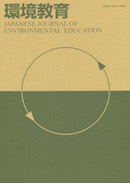Volume 31, Issue 3
Displaying 1-8 of 8 articles from this issue
- |<
- <
- 1
- >
- >|
Special Interview
-
2021Volume 31Issue 3 Pages 3_3-9
Published: 2021
Released on J-STAGE: February 23, 2022
Download PDF (955K)
Research Article
-
2021Volume 31Issue 3 Pages 3_10-20
Published: 2021
Released on J-STAGE: February 23, 2022
Download PDF (1094K) -
2021Volume 31Issue 3 Pages 3_21-32
Published: 2021
Released on J-STAGE: February 23, 2022
Download PDF (942K) -
2021Volume 31Issue 3 Pages 3_33-42
Published: 2021
Released on J-STAGE: February 23, 2022
Download PDF (1020K)
Commentary
-
2021Volume 31Issue 3 Pages 3_43-48
Published: 2021
Released on J-STAGE: February 23, 2022
Download PDF (787K)
Material
-
2021Volume 31Issue 3 Pages 3_49-54
Published: 2021
Released on J-STAGE: February 23, 2022
Download PDF (1706K)
Report of the Branch Annual Meeting
-
2021Volume 31Issue 3 Pages 3_55-60
Published: 2021
Released on J-STAGE: February 23, 2022
Download PDF (1028K)
-
2021Volume 31Issue 3 Pages 3_62-62
Published: 2021
Released on J-STAGE: February 23, 2022
Download PDF (1039K)
- |<
- <
- 1
- >
- >|
